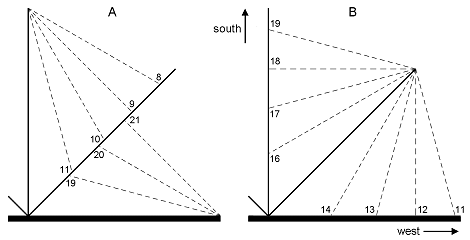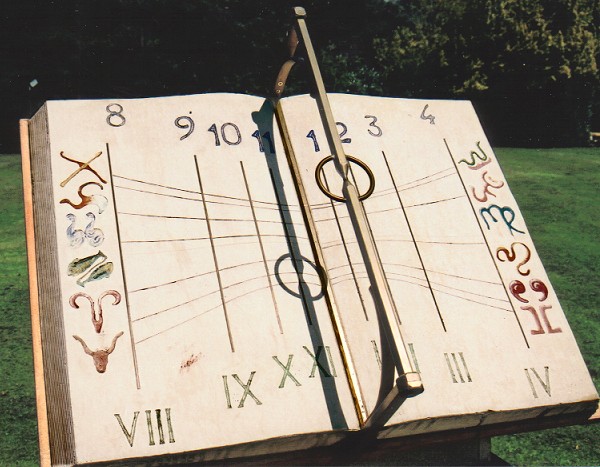
Sundial Park Genk
12. The Book of Time

The open book is a classical form of the polar sundial. The dial face is parallel to the pole-style, so that the hour lines are also parallel. An index on the pole-style indicates the date, as is also the case with the horizontal dial (nr. 2).
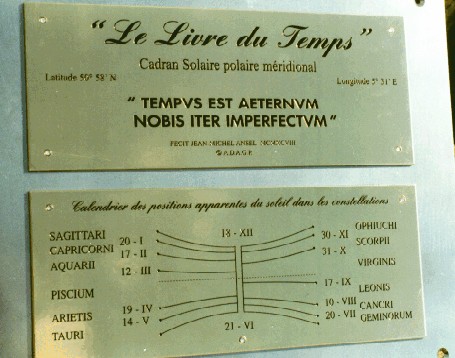
A small plaque at the back of the support has the motto: Tempus est aeternum, nobis iter imperfectum, which means: "Time is eternal, our path imperfect". As the designer explained to me, the word imperfect may be read in both its meanings: 'unfinished', as the universe is infinite, and 'not perfect', as man cannot get free from his animal roots. A second plaque lists the constellations and the dates corresponding with the date lines on the dial face.
The sundial has been designed by the French artist Jean-Michel Ansel.
My comments:
Vulnerable gnomon
The gnomon consisted initially of two six-sided rods, like pencils touching each other at their tips. The constriction served as index. The picture below, by Jean Michel Ansel, was taken on the day of the official start of the project, 20 June 1998, apparently in the early morning.
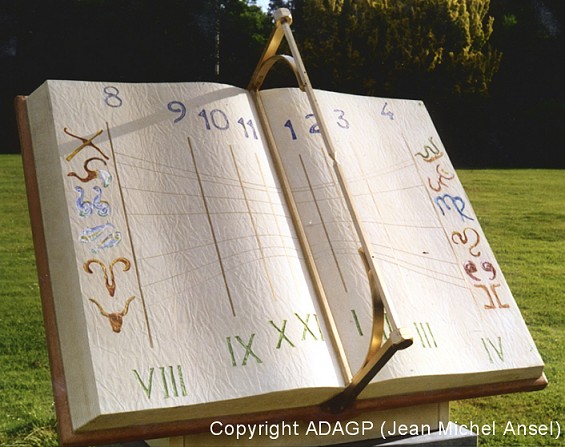
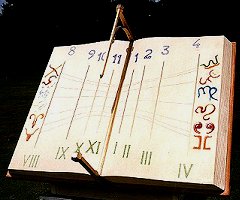 A nice design, but too vulnerable for a public park. One month later the gnomon had perished already.
A nice design, but too vulnerable for a public park. One month later the gnomon had perished already.
The pictures below come from the website of the Flemish Sundial Society (left) and from the brochure (right). When they were taken, I don't know. Anyway, the style in the picture at right is too close to the dial face, and the index is gone.
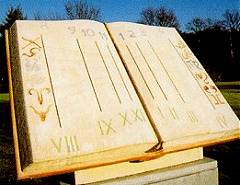 |
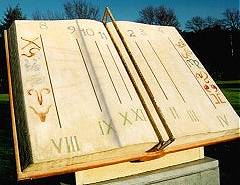 |
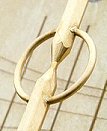 The index had returned in March 2000, reinforced by a ring. And this construction holds since.
The index had returned in March 2000, reinforced by a ring. And this construction holds since.
The date lines
Date lines are often drawn for the first day of each zodiacal month, and marked by the corresponding sign. According to the information panel as well as the brochure, that is the case here too. Not so, obviously. This is already clear from the irregular spacing of the date lines; see the top picture. Instead, the constellations are used which are traversed by the sun during its annual journey over the ecliptic. This is also what the plaque on the back says, be it in French. Adding to the confusion, the date lines are marked by symbols that mostly have a strong resemblance to the zodiacal symbols.
Thirteen constellations are lying on the ecliptic. Twelve bear the same names as the signs of the zodiac; Ophiuchus (serpent bearer) is the additional one. The figure below lists them, together with the corresponding starting dates. These are taken from the plaque and are said to apply to the year 2000. They can vary by a day or so, depending on the phase in the leap-year cycle. Ansel has omitted Libra and added the passing time (23 days!) to Scorpius, which itself takes only 6 days on the ecliptic. He unjustly refers to the ancient Chaldeans (Babylonians) for this omission. He has sneaked Libra in, though, by painting a small pair of scales between the pincers in the symbol of Scorpius.
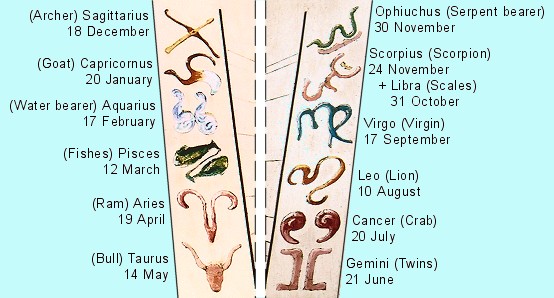
Broadly speaking, the sun's appearance in the various constellations lags about a month behind its entrance into the zodiacal namesake. This is caused by the precession, the slow wobbling of the earth's axis with a 26,000 year period. The names of the constellations and the zodiacal signs were thus introduced over 2000 years ago (about 1/12th of the precession period).
See this page for a listing of the dates and symbols of the zodiacal signs.
The polar dial defined
A polar sundial is commonly defined as a pole-style dial with its dial face parallel to the earth's axis. This would include the vertical east and west dials, as found in the polyhedron dial (nr. 4). In a strict definition, the dial face should also contain the east-west direction. This also implies that the dial face is flat. A slight curvature, as in this book, is usually allowed. Note that the date lines get a brace-like shape in that case.
More on polar dials in this page.
Arabic and Roman numerals
The hours are marked here with Arabic as well as Roman numerals. Why?
One advantageous use that I see sometimes made is on dials that read local as well as standard time (or, more precisely, local time for the meridian that governs the local time zone). The local, 'historic' hours are then indicated by Roman numerals, the 'modern' hours by Arabic numerals.
By spelling the Roman 4-hr number as IV, Ansel takes position in the four o'clock debate.
Book dials
Another form of book dial can be found in the Maarten van Rossum Museum in Zaltbommel (Netherlands). From a wooden open book, three metal pages arise, one vertical, two at 45°. The book rests on an inclined desk, so that the horizontal pages become a polar dial. It is estimated to be several centuries old and came probably from a former monastery in the region.
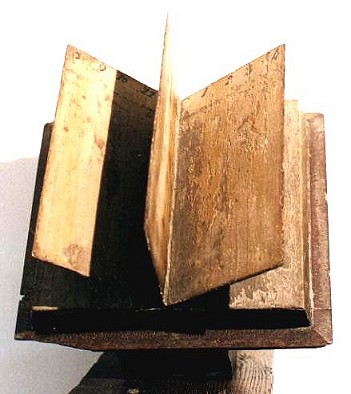
The edge of each page serves as pole-style for the hour bands that top the neighboring pages. This is worked out in the following scheme, which presents a transverse section, seen from the celestial pole, and is limited to the western half of the sundial. (A) shows the hour lines generated by the edges of the horizontal and vertical pages, (B) the same for the tilted page. The vertical page lies itself in the 12 hr plane, the tilted page in the 15 hr plane and the horizontal page in the 18 hr plane.
